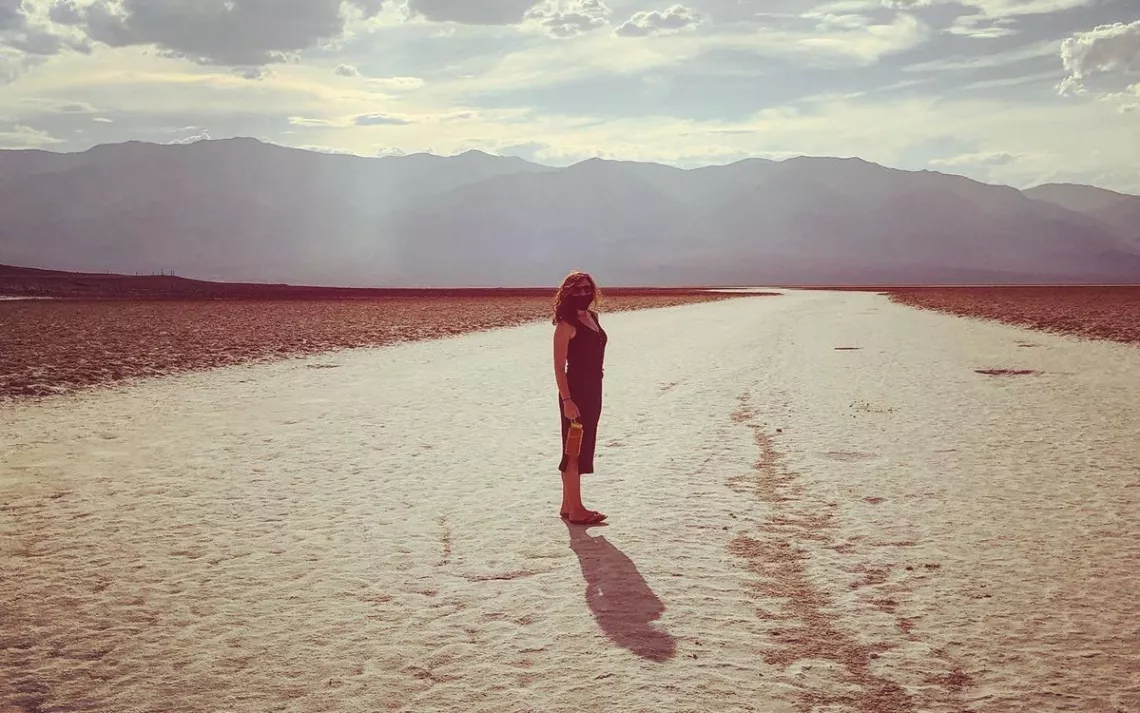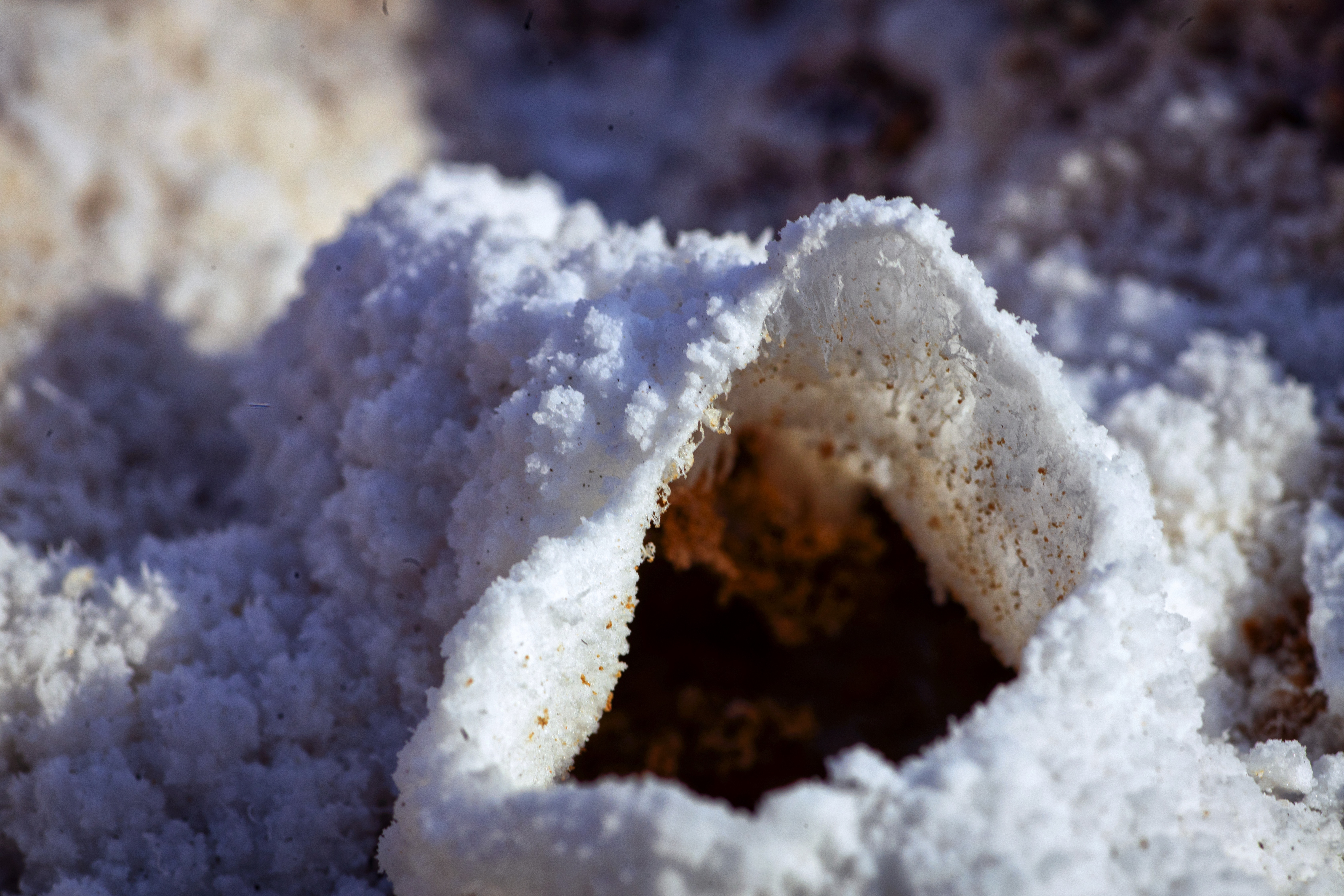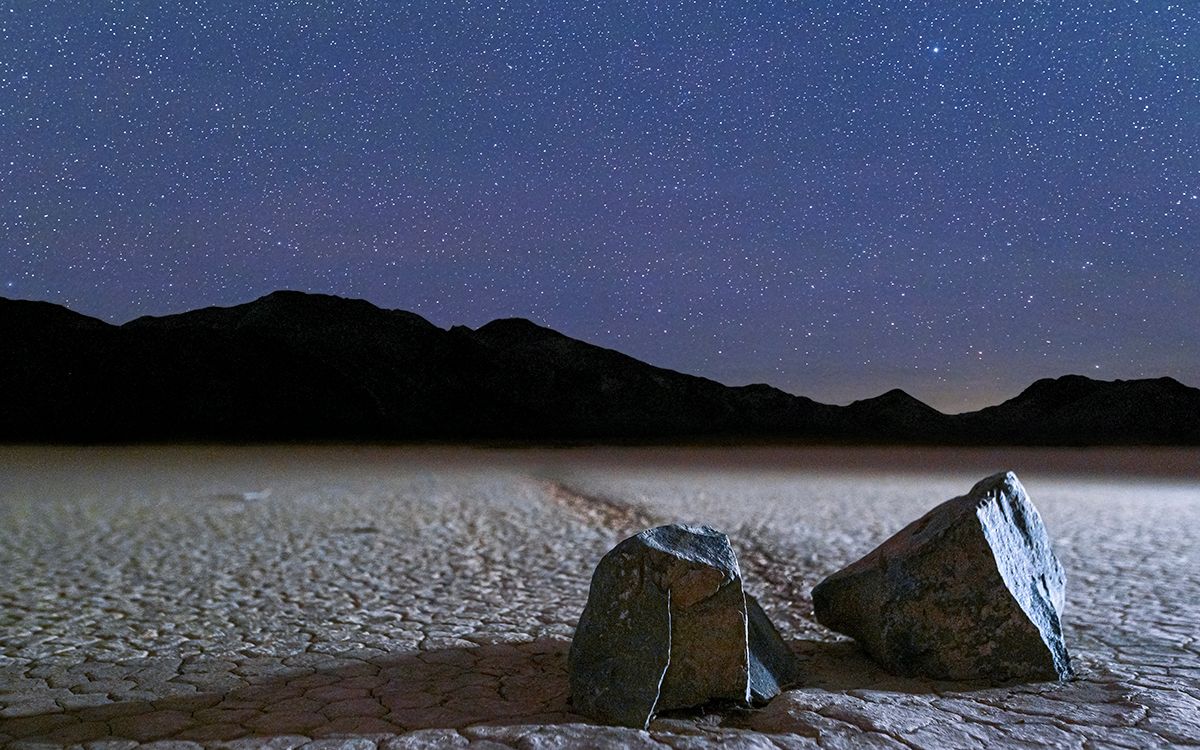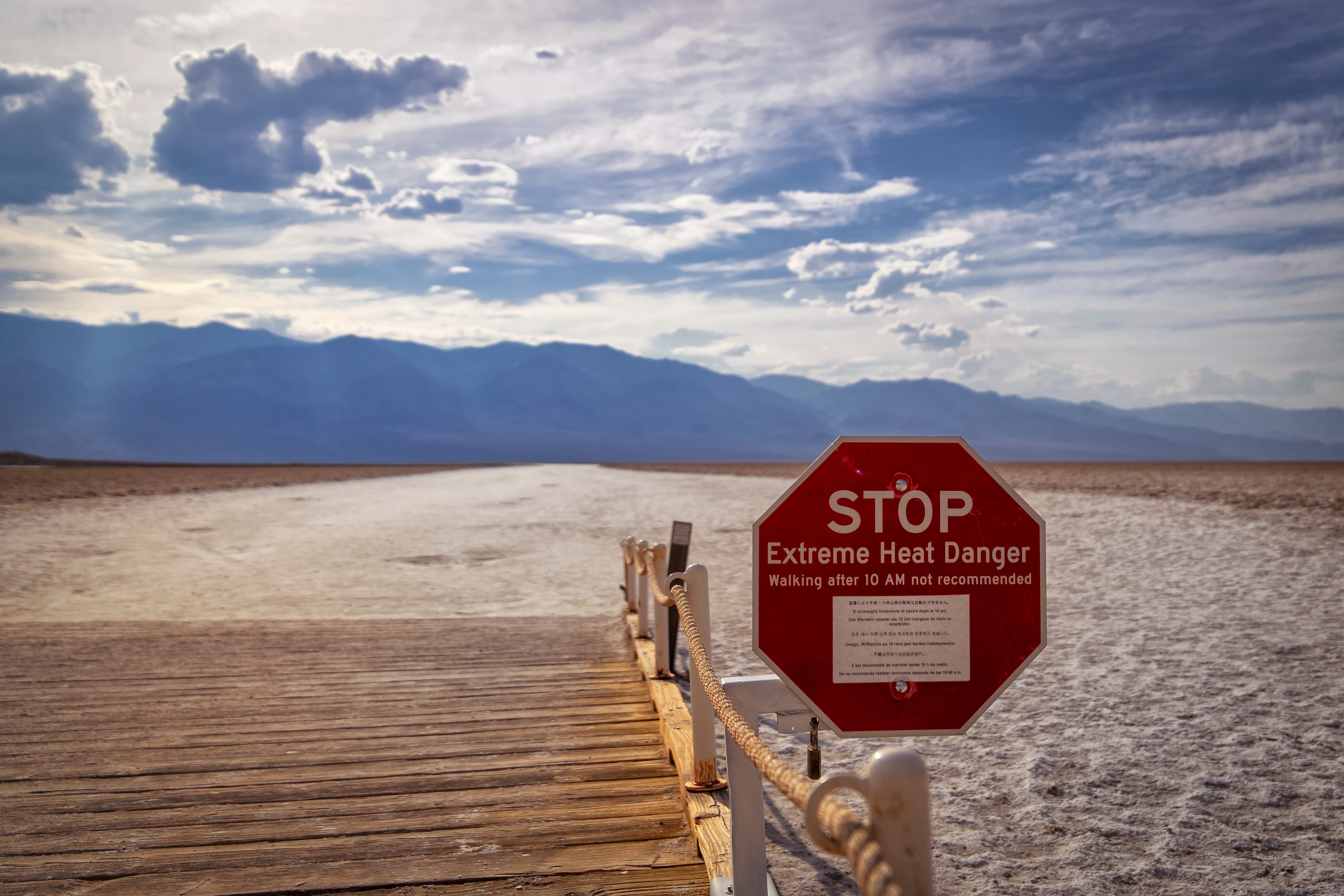The Hottest Day Ever, and I Was There
The blast of a million hair dryers—that’s what it felt like

Photos by Kevin McMullen
We were standing in the lowest point of majestically desolate Death Valley National Park—Badwater Basin, where the floors are salt flats and the walls are two-mile-high mountains. Nestled high above us in the rock face, a sign read “Sea Level” in block-white Hollywood-sign lettering.
But Kevin, my boyfriend, was looking into his phone, crestfallen at missing the show back home: “There’s a ton of lightning in San Francisco right now!” Considering that it was 122 degrees Fahrenheit, I had no idea how his phone could withstand the heat rising up from the white-hot salt crystals crunching underfoot. We didn’t know then that those rare bolts were sparking catastrophic wildfires in the counties surrounding our Bay Area home. Nor did we realize that we had a front-row seat to a different face of climate catastrophe, right there in Death Valley—a new world heat record.
 A breeze picked up, creating a sensation far from pleasant on my skin—the desert may as well have been blasting a million blow-dryers at us. Death Valley is a rain-shadow desert, meaning nearby mountain ranges drain moisture from incoming weather systems. The dryness of the region is compounded by the 282-foot-sub-sea-level depression of the valley floor. Needless to say, the world’s hottest and driest 3,000-square-mile pocket would be treating us to no surprise summer storms.
A breeze picked up, creating a sensation far from pleasant on my skin—the desert may as well have been blasting a million blow-dryers at us. Death Valley is a rain-shadow desert, meaning nearby mountain ranges drain moisture from incoming weather systems. The dryness of the region is compounded by the 282-foot-sub-sea-level depression of the valley floor. Needless to say, the world’s hottest and driest 3,000-square-mile pocket would be treating us to no surprise summer storms.
I expressed my sympathies that we were 500 miles from the bolts to Kevin, who’s obsessed with the sky; specifically, with capturing its phenomena on film using wide-angle lenses and special astro gear. Lightning photos would be cool, I told him, but Milky Way shots, set against Death Valley’s sand dunes and sailing stones and hexagonal salt flats, would be infinitely cooler.
That weekend would see the last new moon of Milky Way season, which is part of what had brought us to the least hospitable place on Earth in the dead of August. Kevin’s a hobby astrophotographer, on a mission to capture quintessential vistas of the night sky in each of California’s national parks before the year’s end. Hanging out with him has turned me into something of a nocturnal telescope mule. Not that I’m complaining—I love journeying deep into landscapes in the dead of night, when they’re void of fellow human visitors and a touch spooky.
And I’d long wanted to see the surreal Death Valley, where pastel-colored canyons have been rearranging themselves kaleidoscopically over the past 3 million years and vast slabs of rock descend into a valley growing ever deeper. What’s more, we were, and of course still are, in the midst of the coronavirus pandemic. What could be more inherently social distancing, we figured, than vacationing at contiguous America’s largest-yet-least-visited national park during its furnacey off-season?
Whatever we may have gained in COVID-19 safety bona fides, we sacrificed in pervasive fear of death from baking. The first night, in the barren nadir of Badwater Basin, I left the overhead light on in the car. Had Kevin not noticed it—at 10 P.M., after we’d trekked 50 yards out onto the salt flats in 115° temps to capture data for photos—our continued existence would have been at the mercy of roadside assistance, some 70 miles away. Another day, while climbing the hundred or so yards from another parking lot up to Zabriskie Point, an iconic vista starring ethereal purple-blue sunsets, we noticed a trail of what appeared to be human vomit, drying in the 8 P.M. sun and daring us to venture further.
Suffice to say, nothing stands in heat’s way here. In the summer of 1913, a weather observer reported a temperature of 134°. Meteorologists are skeptical of that measure, but the valley has just gotten dryer and hotter since it got its name in 1849, when a gold-seeking pioneer, escaping west over the nearby Panamint Mountains after a treacherous journey through the valley, exclaimed, “Goodbye, Death Valley!” (He was presumably invoking Psalm 23:4—“Yea, though I walk through the valley of the shadow of death.”) The macabre motif caught on—future visitors went on to christen the valley’s natural features with names like Devil’s Golf Course, Coffin Canyon, Dante’s View, and Hells Gate.
Kevin and I had no way of knowing that on the last day of our visit, we’d become VIPs at the inferno. That weekend, California experienced a blistering heat wave, with many parts of the state sizzling in triple-digit temps. On Sunday, August 16, the thermometer in Death Valley’s aptly named Furnace Creek, right near the hotel where we were staying, hit 130°, the highest temperature ever reliably recorded on Earth.
We received word of the record at five the next morning, after we’d sleepily made our way back to Furnace Creek following a night spent shooting the sailing stones (pictured, below), famous for their bizarre, race-car-like movement across Death Valley’s dry lake bed, known as Racetrack Playa. (They’re blown by the wind and skate on a thin layer of ice in the colder months. I’d napped on the seemingly endless mud flat, while bats fluttered overhead and glowy-eyed kit foxes eyed our snack supply. Kevin, meanwhile, had used flashlights to locate the elusive stones’ racetracks, so as to photograph them against the sky’s galactic backdrop.)

To be honest, the news was exciting in its ominousness—a superlative to vindicate all our complaints about how much the heat hurt, how badly we were melting. It briefly eclipsed the overwhelming anxiety we’d experienced all weekend, wondering whether we’d brought enough coolant for the car, debating whether SPF 70 would be enough to protect us, and heeding staffers’ foreboding “Careful out there!” warnings every time we headed out.
Once we left the arid wilderness for San Francisco and caught up on the news we’d missed while focused on surviving Death Valley’s heat, though, we realized the 130° mark had capped a week of bizarrely horrifying weather. The previous day, a rare fire tornado had formed near Chilcoot, California, worsened by the heat wave. A few days before that, a violent straight-wind derecho had devastated parts of Iowa. Meanwhile, the Atlantic was setting hurricane records, with 11 forming before peak season. The same thing was happening in fire country–the closer we crept to the Bay, the redder the sun grew, shining sinisterly through thick, smoky air. We returned to find that friends and colleagues had been evacuated from their homes—some among those 10,000 lightning strikes we’d missed had gone on to destroy facilities at Big Basin Redwoods State Park, California’s oldest state park, and more.
The closer we got to San Francisco, the less I felt so front-row-and-center special—we were pretty much all sitting too close to the screen at the summer blockbuster that is the climate catastrophe.
The Earth’s crust was violently pulled apart to create Death Valley’s stark melodrama some 3 million years ago—in geologic time, just the other day. Since my superlative trip to the desert, I’ve begun fantasizing about existence on this time table. Because compared with global warming’s dizzying acceleration, the roiling processes at work in Death Valley—the folding and twisting of rock formations over millions of years—create a different, oddly comforting, kind of chaos. A slow-burn I’d give anything to see replicated on a climactic scale.
Being alive during the Anthropocene, unfortunately, means that until we can slow and ideally reverse climate change, we’ll be forever marching in one never-ending parade of superlatives. Hottest. Driest. Wettest. Most flooded. Most acidified. If Death Valley offers our closest taste of life lived on geologic time, then take me back there, please (but next time, during winter!).

 The Magazine of The Sierra Club
The Magazine of The Sierra Club



